Abstract
Receptor specificity of the substance P-related peptides neurokinin A and neurokinin B was studied in the isolated guinea pig ileum. Substance P and the recently discovered neurokinins elicit contraction of the ileum both directly through action on a muscle cell receptor and indirectly through stimulation of a neuronal receptor, leading to release of acetylcholine, which causes muscle contraction via muscarinic receptors. Two specific assay procedures for the function of the neuronal receptor were developed. The muscular receptor was inactivated either by desensitization with the selective agonist substance P methyl ester or by receptor blockade with the selective antagonist [Arg6, D-Trp7,9, Me-Phe8]substance P-(6-11) hexapeptide. Both procedures revealed that the neuronal receptor is clearly distinct from the muscular receptor, since it exhibits different agonist specificity and is insensitive to antagonists of the muscular receptor. Neurokinin B was found to be the most potent agonist (EC50 = 1 nM) for the neuronal receptor. Furthermore, [D-Ala2, Met5]enkephalinamide inhibited in a naloxone-sensitive manner the effect of neurokinin B mediated via the neuronal receptor. These results suggest that the different mammalian tachykinins can play specific physiological roles by virtue of their distinct receptor specificities.
Full text
PDF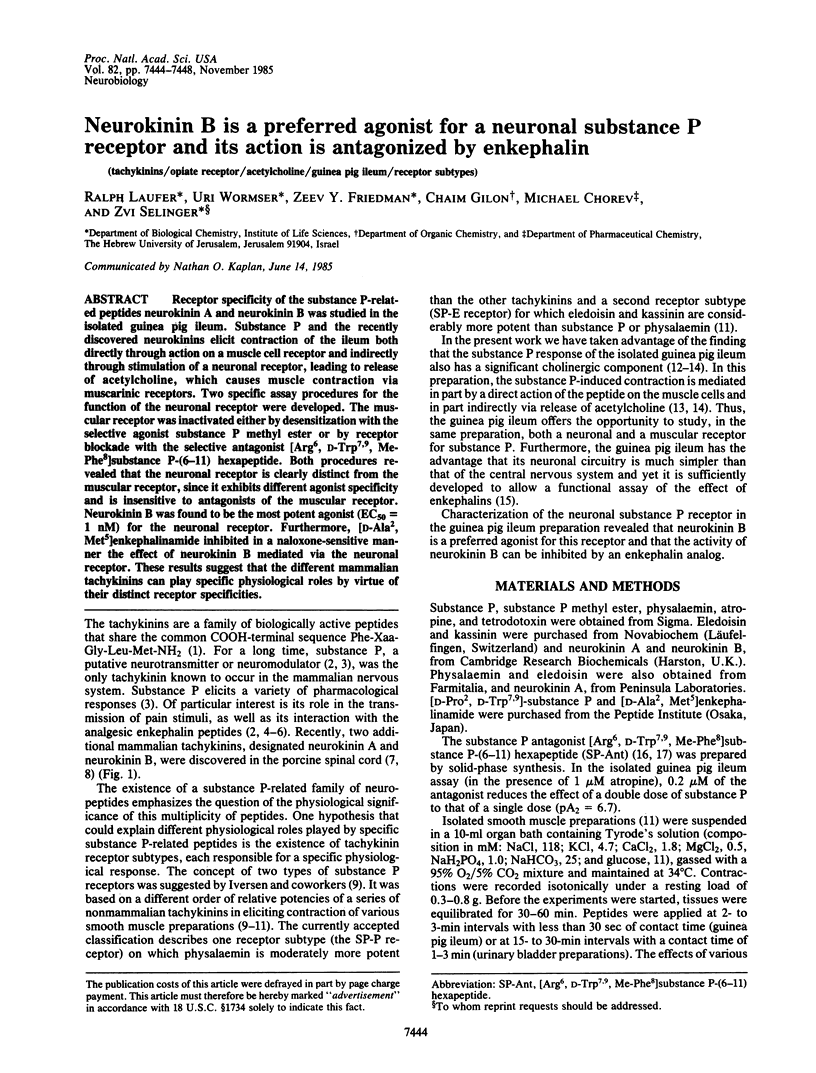
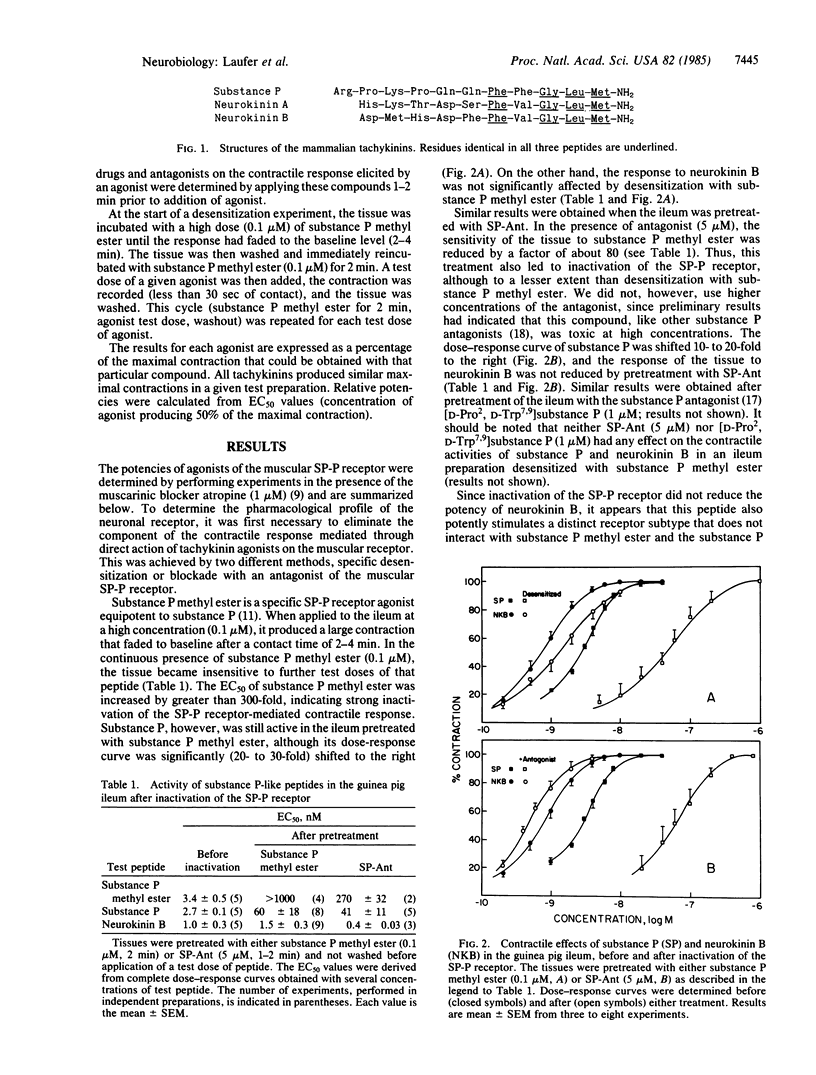
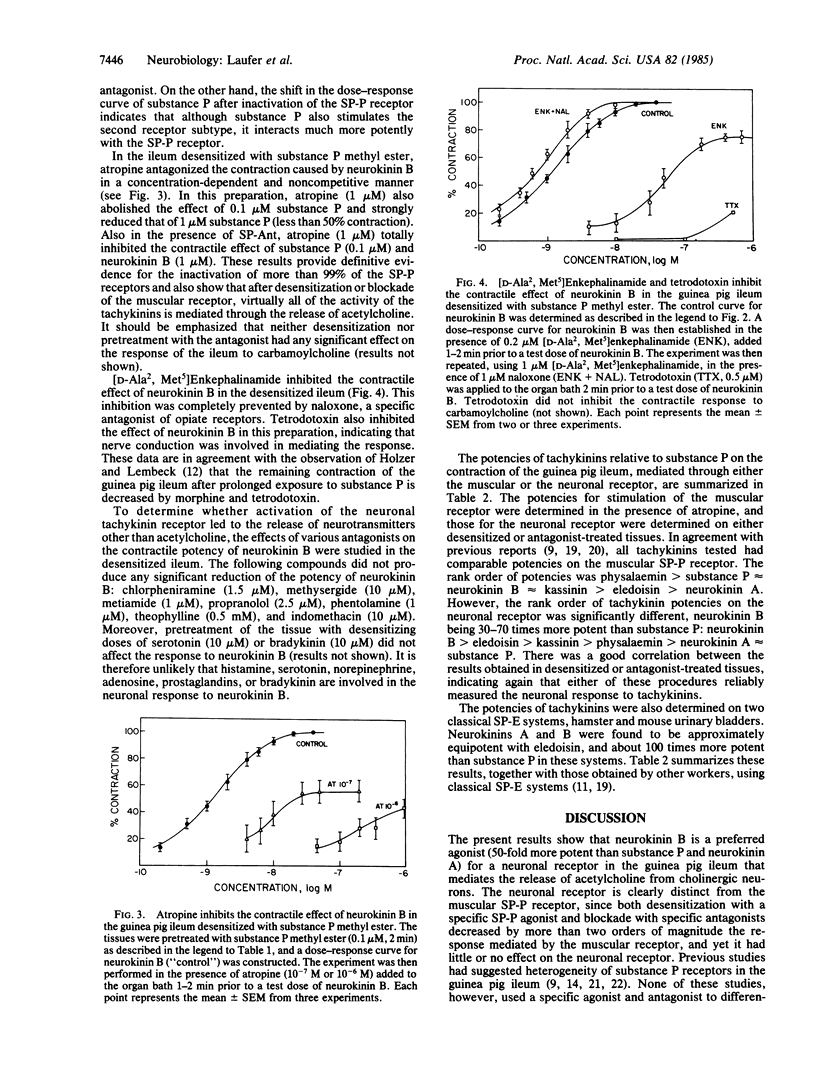
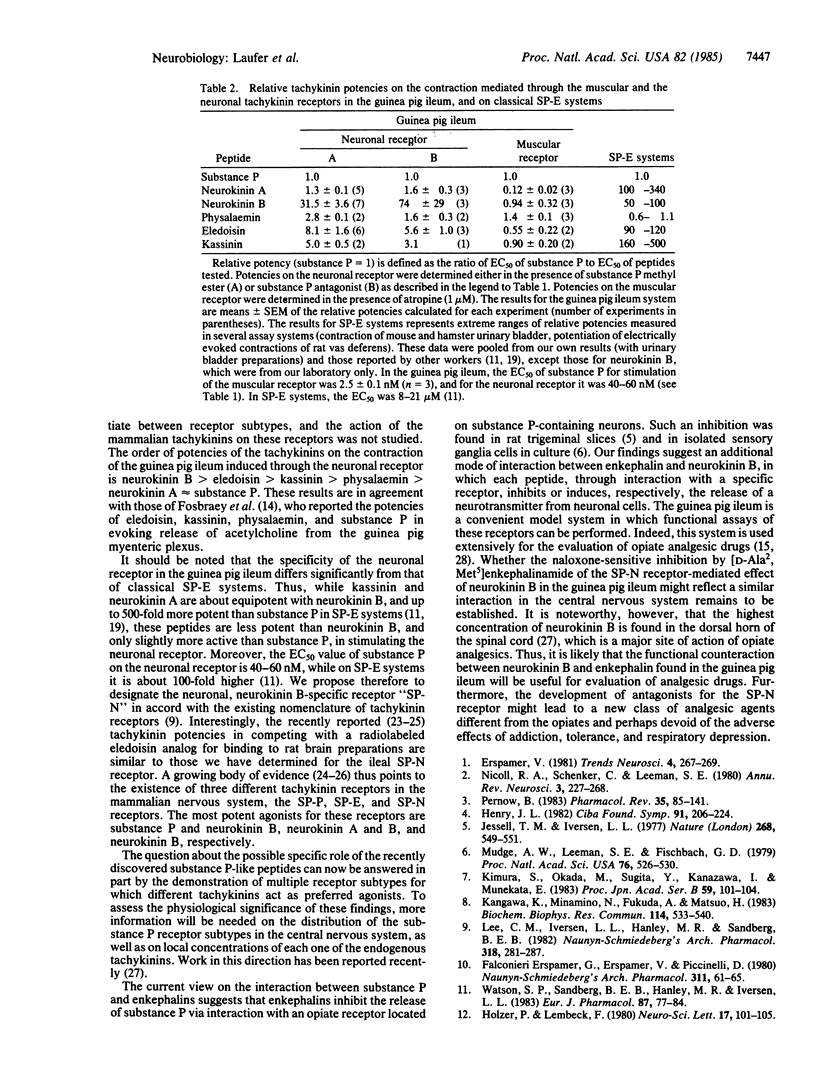
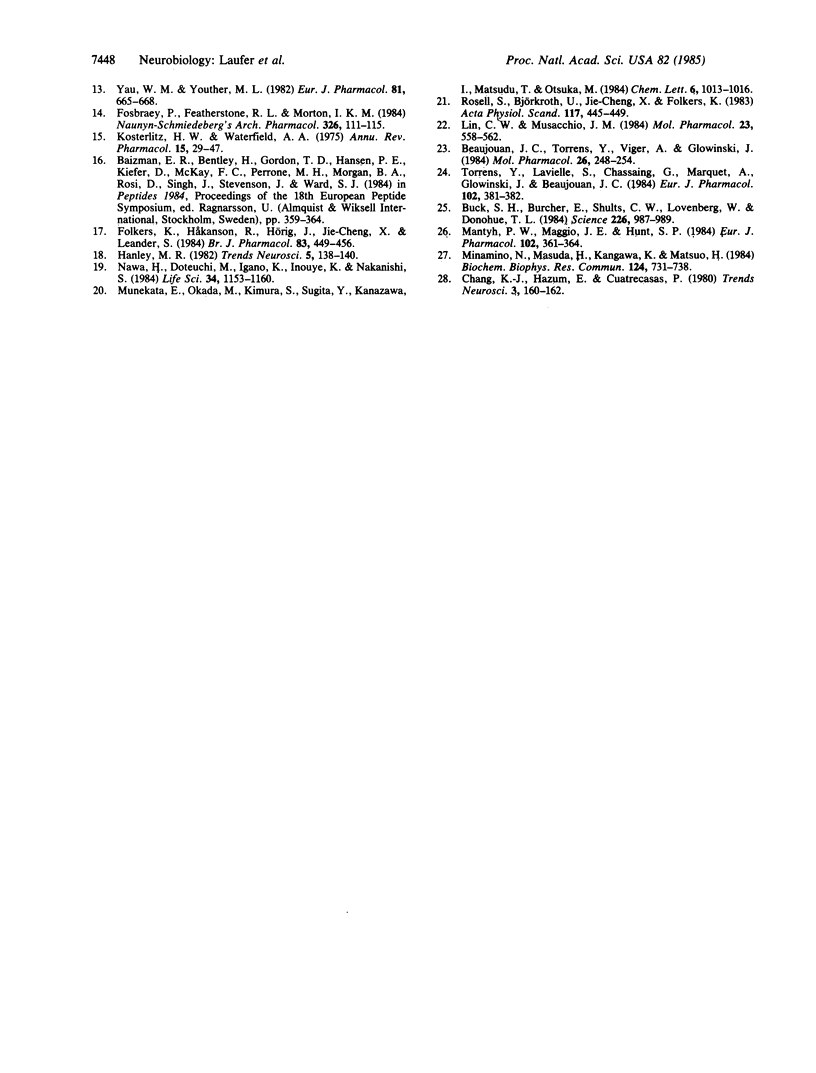
Selected References
These references are in PubMed. This may not be the complete list of references from this article.
- Beaujouan J. C., Torrens Y., Viger A., Glowinski J. A new type of tachykinin binding site in the rat brain characterized by specific binding of a labeled eledoisin derivative. Mol Pharmacol. 1984 Sep;26(2):248–254. [PubMed] [Google Scholar]
- Buck S. H., Burcher E., Shults C. W., Lovenberg W., O'Donohue T. L. Novel pharmacology of substance K-binding sites: a third type of tachykinin receptor. Science. 1984 Nov 23;226(4677):987–989. doi: 10.1126/science.6095447. [DOI] [PubMed] [Google Scholar]
- Erspamer G. F., Erspamer V., Piccinelli D. Parallel bioassay of physalaemin and kassinin, a tachykinin dodecapeptide from the skin of the African frog Kassina senegalensis. Naunyn Schmiedebergs Arch Pharmacol. 1980 Feb;311(1):61–65. doi: 10.1007/BF00500303. [DOI] [PubMed] [Google Scholar]
- Folkers K., Håkanson R., Hörig J., Xu J. C., Leander S. Biological evaluation of substance P antagonists. Br J Pharmacol. 1984 Oct;83(2):449–456. doi: 10.1111/j.1476-5381.1984.tb16506.x. [DOI] [PMC free article] [PubMed] [Google Scholar]
- Fosbraey P., Featherstone R. L., Morton I. K. Comparison of potency of substance P and related peptides on [3H]-acetylcholine release, and contractile actions, in the guinea-pig ileum. Naunyn Schmiedebergs Arch Pharmacol. 1984 Jun;326(2):111–115. doi: 10.1007/BF00517306. [DOI] [PubMed] [Google Scholar]
- Henry J. L. Relation of substance P to pain transmission: neurophysiological evidence. Ciba Found Symp. 1982;(91):206–224. doi: 10.1002/9780470720738.ch12. [DOI] [PubMed] [Google Scholar]
- Holzer P., Lembeck F. Neurally mediated contraction of ileal longitudinal muscle by substance P. Neurosci Lett. 1980 Apr;17(1-2):101–105. doi: 10.1016/0304-3940(80)90069-5. [DOI] [PubMed] [Google Scholar]
- Jessell T. M., Iversen L. L. Opiate analgesics inhibit substance P release from rat trigeminal nucleus. Nature. 1977 Aug 11;268(5620):549–551. doi: 10.1038/268549a0. [DOI] [PubMed] [Google Scholar]
- Kangawa K., Minamino N., Fukuda A., Matsuo H. Neuromedin K: a novel mammalian tachykinin identified in porcine spinal cord. Biochem Biophys Res Commun. 1983 Jul 29;114(2):533–540. doi: 10.1016/0006-291x(83)90813-6. [DOI] [PubMed] [Google Scholar]
- Kosterlitz H. W., Waterfield A. A. In vitro models in the study of structure-activity relationships of narcotic analgesics. Annu Rev Pharmacol. 1975;15:29–47. doi: 10.1146/annurev.pa.15.040175.000333. [DOI] [PubMed] [Google Scholar]
- Lee C. M., Iversen L. L., Hanley M. R., Sandberg B. E. The possible existence of multiple receptors for substance P. Naunyn Schmiedebergs Arch Pharmacol. 1982 Mar;318(4):281–287. doi: 10.1007/BF00501166. [DOI] [PubMed] [Google Scholar]
- Lin C. W., Musacchio J. M. The determination of dissociation constants for substance P and substance P analogues in the guinea pig ileum by pharmacological procedures. Mol Pharmacol. 1983 May;23(3):558–562. [PubMed] [Google Scholar]
- Mantyh P. W., Maggio J. E., Hunt S. P. The autoradiographic distribution of kassinin and substance K binding sites is different from the distribution of substance P binding sites in rat brain. Eur J Pharmacol. 1984 Jul 13;102(2):361–364. doi: 10.1016/0014-2999(84)90269-3. [DOI] [PubMed] [Google Scholar]
- Minamino N., Masuda H., Kangawa K., Matsuo H. Regional distribution of neuromedin K and neuromedin L in rat brain and spinal cord. Biochem Biophys Res Commun. 1984 Nov 14;124(3):731–738. doi: 10.1016/0006-291x(84)91019-2. [DOI] [PubMed] [Google Scholar]
- Mudge A. W., Leeman S. E., Fischbach G. D. Enkephalin inhibits release of substance P from sensory neurons in culture and decreases action potential duration. Proc Natl Acad Sci U S A. 1979 Jan;76(1):526–530. doi: 10.1073/pnas.76.1.526. [DOI] [PMC free article] [PubMed] [Google Scholar]
- Nawa H., Doteuchi M., Igano K., Inouye K., Nakanishi S. Substance K: a novel mammalian tachykinin that differs from substance P in its pharmacological profile. Life Sci. 1984 Mar 19;34(12):1153–1160. doi: 10.1016/0024-3205(84)90087-0. [DOI] [PubMed] [Google Scholar]
- Nicoll R. A., Schenker C., Leeman S. E. Substance P as a transmitter candidate. Annu Rev Neurosci. 1980;3:227–268. doi: 10.1146/annurev.ne.03.030180.001303. [DOI] [PubMed] [Google Scholar]
- Pernow B. Substance P. Pharmacol Rev. 1983 Jun;35(2):85–141. [PubMed] [Google Scholar]
- Rosell S., Björkroth U., Xu J. C., Folkers K. The pharmacological profile of a substance P (SP) antagonist. Evidence for the existence of subpopulations of SP receptors. Acta Physiol Scand. 1983 Mar;117(3):445–449. doi: 10.1111/j.1748-1716.1983.tb00019.x. [DOI] [PubMed] [Google Scholar]
- Torrens Y., Lavielle S., Chassaing G., Marquet A., Glowinski J., Beaujouan J. C. Neuromedin K, a tool to further distinguish two central tachykinin binding sites. Eur J Pharmacol. 1984 Jul 13;102(2):381–382. doi: 10.1016/0014-2999(84)90276-0. [DOI] [PubMed] [Google Scholar]
- Watson S. P., Sandberg B. E., Hanley M. R., Iversen L. L. Tissue selectivity of substance P alkyl esters: suggesting multiple receptors. Eur J Pharmacol. 1983 Jan 28;87(1):77–84. doi: 10.1016/0014-2999(83)90052-3. [DOI] [PubMed] [Google Scholar]
- Yau W. M., Youther M. L. Direct evidence for a release of acetylcholine from the myenteric plexus of guinea pig small intestine by substance P. Eur J Pharmacol. 1982 Jul 30;81(4):665–668. doi: 10.1016/0014-2999(82)90357-0. [DOI] [PubMed] [Google Scholar]


